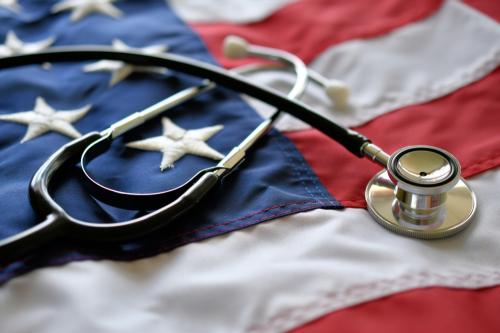More than 800,000 Americans between the ages of 62 and 64 have no health insurance and are, therefore, one serious medical problem away from financial ruin. About the same number purchase individual coverage, which can be quite expensive, both because they are less healthy than younger adults and because the costs of marketing and administering individual policies are high. Within these two groups, a few more than half receive reduced Social Security benefits available to early retirees age 62 to 64. Just more than one-quarter are working and not collecting Social Security. The balance, most spouses of workers whose employers do not provide group health insurance coverage, neither work nor receive Social Security. Of the total, close to 40 percent have low incomes, that is, incomes below twice the poverty level.
To address the financial risk facing the uninsured and the burden high premiums impose on purchasers of individual policies, the president has proposed that 62- to 63-year-olds be allowed to enroll in Medicare, which is now available only to the permanently disabled and those 65 and older. To keep this expansion from bankrupting a program projected to become insolvent at about the end of the first decade of the next century, the proposal would require that these enrollees buy into Medicare by paying a monthly premium of about $300 until their 65th birthday. After that, they would pay a small surcharge on the Part B premiums all Medicare participants pay.
While the president’s initiative is a positive step toward reducing both the risk of serious illnesses wiping out the retirement savings of uncovered 62- to 64-year-olds and the excessive financial burden that many older purchasers of individual policies now bear, these advances would come at a price. The Medicare buy-in would create incentives that could exacerbate undesirable trends in the nation’s labor markets. Furthermore, once enacted, it would unleash political pressures for liberalization that could cause the costs of this initiative to soar.
If 62- to 64-year-olds could enroll in Medicare, those employers who now provide health insurance coverage for their retirees would feel less need to do so. Many employers already have dropped or scaled back this fringe benefit not only because it is costly but because new accounting rules require businesses to reveal now the benefit expenses they will incur in the future. These policies provide protection for millions who retire before they are eligible for Medicare. For more than one-third of retirees who are covered by Medicare, these employer-sponsored policies also provide supplementary insurance that picks up costs that Medicare does not cover. If more employers drop these policies, more of the elderly will have to turn to individual Medigap insurance for their supplemental coverage. Medigap premiums are generally higher than the premiums employers charge their retirees, and most Medigap plans don’t cover some important services, such as prescription drugs, which are generally covered by employer-sponsored retiree policies.
Availability of Medicare for those age 62 to 64 also will entice more to retire early on reduced Social Security benefits. For those with chronic health problems who have continued to work just to obtain health benefits, this opportunity could be a blessing. But for those who are healthy and have saved little, early retirement could prove to be a mistake. The consequences might not become apparent for a decade or two, perhaps not until their widows try to subsist on the reduced Social Security benefits available to them. As a consequence, more of the very old may have to rely on food stamps and SSI, the welfare program for low-income elderly and disabled. In a nation in which the work force is projected to grow at a slower and slower pace, public policy should encourage increased labor-force participation by the elderly rather than promote early retirement.
A Medicare buy-in option also might encourage employers to shift their older workers from full- to part-time status or from being regular employees to being contract employees. An older worker with a chronic health condition could cost a business that offers health benefits far more than the Medicare buy-in premium. In such a case, a business would come out ahead if it offered workers a pay raise larger than the premium they would be charged for buying into Medicare if they became contract employees.
While the president’s proposal is intended to be budget-neutral to begin with—that is, the premiums charged 62- to 64-year-old participants would cover the added Medicare costs—it would prove difficult to maintain such fiscal rectitude. Most of those who take advantage of the buy-in option would be living in quite comfortable circumstances. Few of those with low and modest incomes would participate because they would feel that they can’t afford to pay $3,600 annually for Medicare coverage. Thus, those who need help the most would get the least, and many would remain uninsured. Over time, pressure would inevitably build to provide some sort of income-related subsidy to allow those with limited resources a real option to participate in the Medicare buy-in.
If, as in the past, Medicare costs rise at a much faster pace than the incomes of those eligible for the buy-in, the burden of the premium will increase. Pressure will mount for a subsidy. That is what happened to Medicare’s Part B premium, which was set to cover half of the program’s costs. But when costs rose faster than participants’ incomes, increases in the premium were limited so that premiums now cover only one-quarter of costs.
While the president’s Medicare initiative raises complex issues, it responds to a significant problem. Rather than trashing the plan, as some in the opposition have done, policymakers should work to mitigate undesirable secondary effects that inevitably accompany efforts to expand access to affordable care. Policymakers also should consider the political pressure they will be under in the long run to liberalize the program and realistically account for the budgetary consequences of that pressure.
The Brookings Institution is committed to quality, independence, and impact.
We are supported by a diverse array of funders. In line with our values and policies, each Brookings publication represents the sole views of its author(s).



Commentary
Op-edThe Medicare for the Almost-Old
January 12, 1998